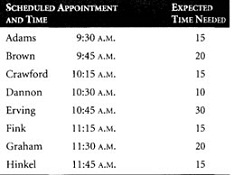Discuss the below:
Q: Dr. Mark Greenberg practices dentistry in Topeka, Kansas. Greenberg tries hard to schedule appointments so that patients do not have to wait beyond their appointment time. His October 20 schedule is shown in the following table.

Unfortunately, not every patient arrives exactly on schedule, and expected times to examine patients are just that-expected. Some examinations take longer than expected, and some take less time.
Greenberg's experience dictates the following:
(a) 20% of the patients will be 20 minutes early.
(b) 10% of the patients will be 10 minutes early.
(c) 40% of the patients will be on time.
(d) 25% of the patients will be 10 minutes late.
(e) 5% of the patients will be 20 minutes late.
He further estimates that
(a) 15% of the time he will finish in 20% less time than expected.
(b) 50% of the time he will finish in the expected time.
(c) 25% of the time he will finish in 20% more time than expected.
(d) 10% of the time he will finish in 40% more time than expected.
Dr. Greenberg has to leave at 12:15 P.M. on October20 to catch a flight to a dental convention in New York. Assuming that he is ready to start his workday at 9:30 A.M. and that patients are treated in order of their scheduled exam (even if one late patient arrives after an early one), will he be able to make the flight? Comment on this simulation.